AWM41 1067 - [Official History, 1914-18 War: Records of Arthur G Butler:] Nursing - Dress - Correspondence with Miss I I Lindsay - Note by Sister E Vickers Foote
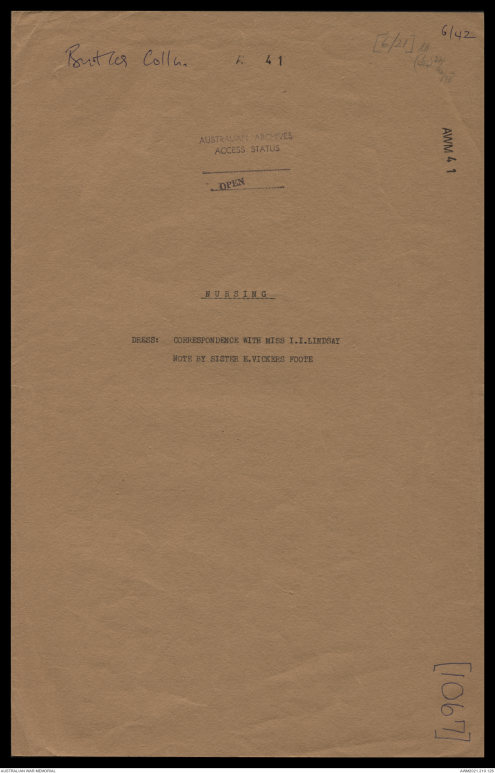
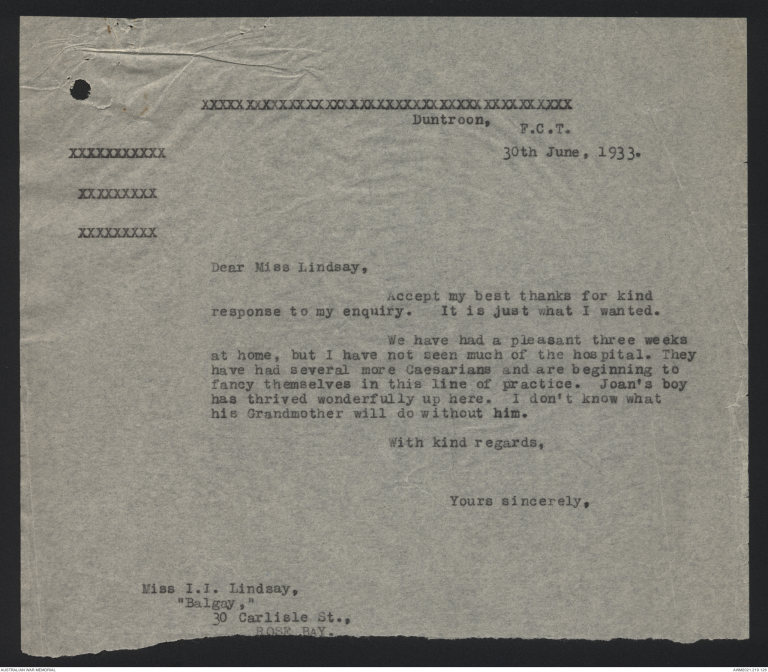
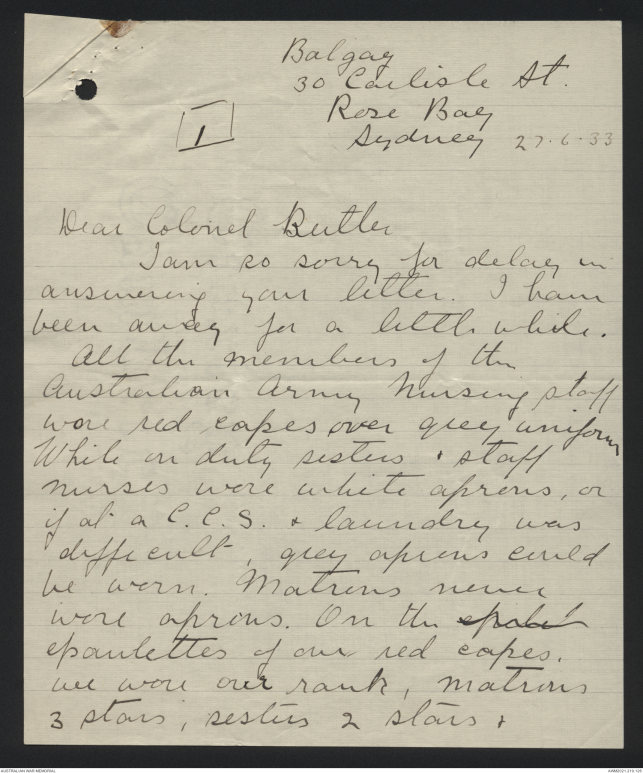

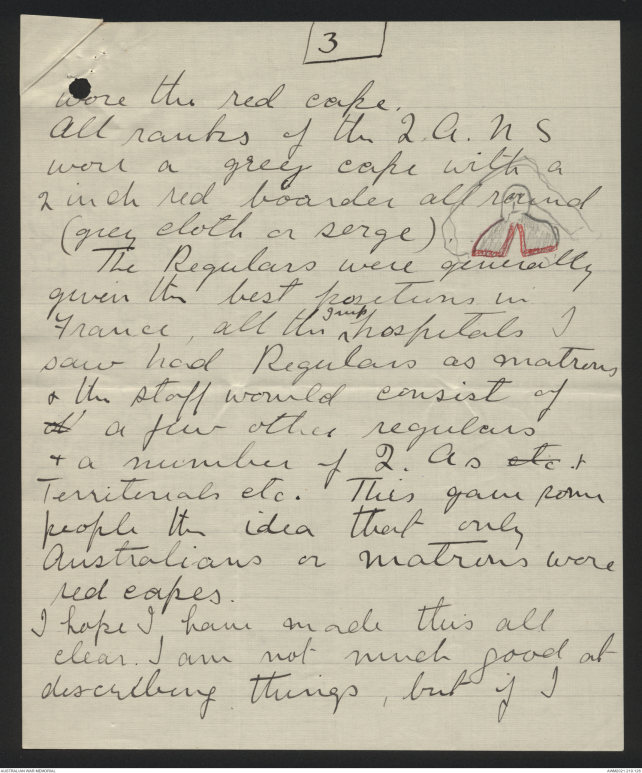

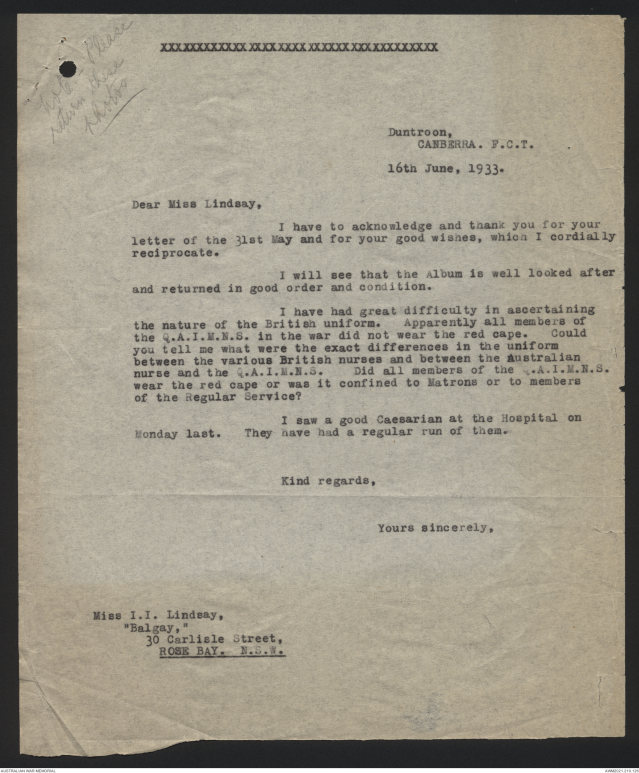
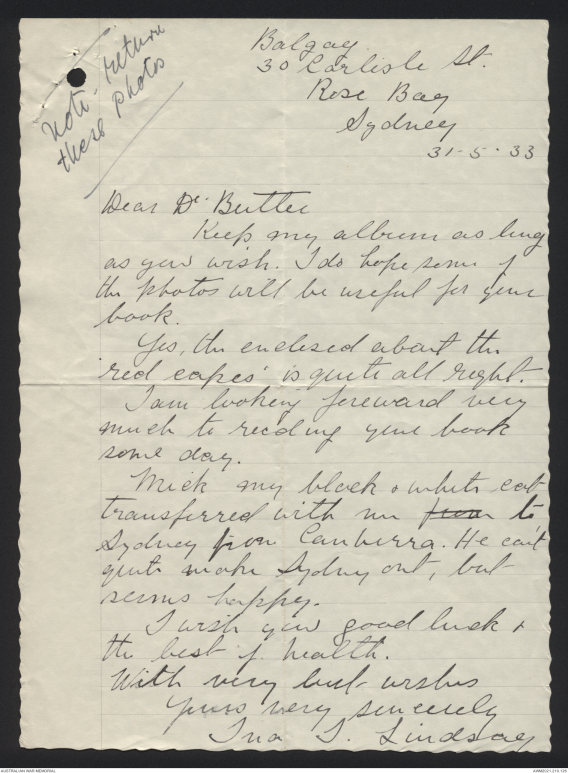
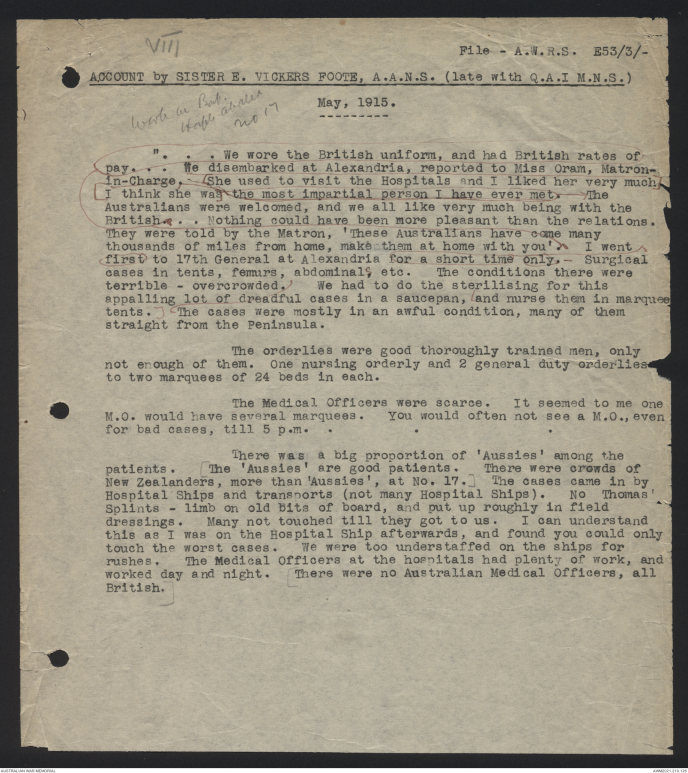
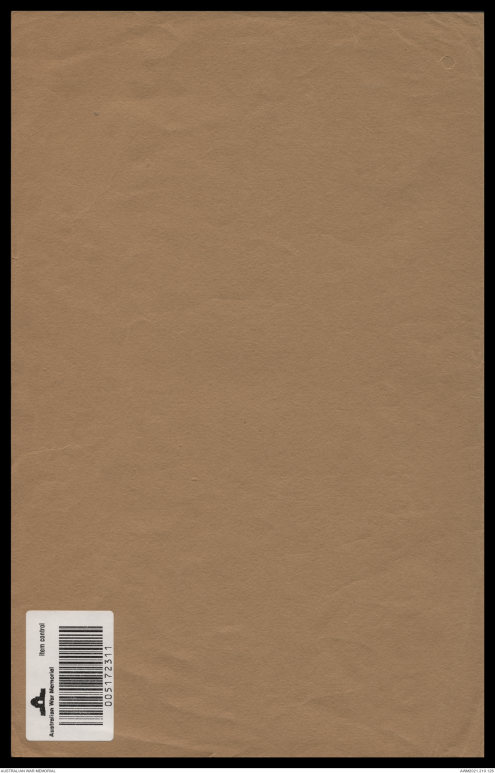
Butler Colln.
E 41
6/42
[6/21]
(32 24/10/48
AUSTRALIAN ARCHIVES
ACCESS STATUS
_______________
OPEN
_______________
AWM 41
NURSING
DRESS: CORRESPONDENCE WITH MISS I.I. LINDSAY
NOTE BY SISTER E.VICKERS FOOTE
[1067]
XXXXXXXXXXXXXXXXXXXXXXXXXXXXXXXXXX
Duntroon,
F.C.T.
30th June, 1933.
XXXXXXXXXX
XXXXXXXXX
XXXXXXXXX
Dear Miss Lindsay,
Accept my best thanks for kind
response to my enquiry. It is just what I wanted.
We have had a pleasant three weeks
at home, but I have not seen much of the hospital. They
have had several more Caesarians and are beginning to
fancy themselves in this line of practice. Joan's boy
has thrived wonderfully up here. I don't know what
his Grandmother will do without him.
With kind regards,
Yours sincerely,
Miss I. I. Lindsay,
"Balgay,"
30 Carlisle St.,
ROSE BAY.
Balgay
30 Carlisle St.
Rose Bay
Sydney
27.6.33
1
Dear Colonel Butler
I am so sorry for delay in
answering your letter. I have
been away for a little while.
All the members of the
Australian Army Nursing Staff
wore red capes over grey uniforms
While on duty sisters & staff
nurses wore white aprons, or
if at a C.C.S. & laundry was
difficult, grey aprons could
be worn. Matrons never
wore aprons. On the epalet
epaulettes of our red capes,
we wore our rank, matrons
3 stars, sisters 2 stars &
2
staff nurses 1 star. Matrons
wore brown cuffs, sisters & staff
nurses white cuffs. We wore colour
of our unit on our sleeves like
the troops. A chocolate star
with a green stripe for 1st A.G.H.
red for 2nd A.G.H. & blue
for 3rd A.G.H.
Diagram, see original document
The Regulars & the 2 A.I.M.S
wore their rank on their
sleeves low down near the
cuff 2 or 3 red stripes according
to rank, & the matrons wore red
cuffs. Sisters & staff nurses wore
white aprons over their grey
dresses while on duty. Matrons
grey dresses & never aprons.
All ranks of the Regulars
3
wore the red cape.
All ranks of the 2 A.N S
wore a grey cape with a
2 inch red boarder all round
(grey cloth or serge)
Diagram, see original document
The Regulars were generally
given the best positions in
France, all the ^Imp hospitals I
saw had Regulars as matrons
& the staff would consist ofN a few other regulars
& a number of 2As etc &
Territorials etc. This gave some
people the idea that only
Australians or Matrons wore
red capes.
I hope I have made this all
clear. I am not much good at
describing things, but if I
4
have not made it clear
enough let me know & I
will write again.
I have done a little specially
in a private hospital since
I came to Sydney. Later on I
hope to get a position.
I hope you are well, &
not having it too cold in
Canberra
Yours sincerely
Ina I. Lindsay.
[*Note - please
return these
photos*]
xxxxxxxxxxxxxxxxxxxxxxxxxxxxxxxxxxxxxxxxx
Duntroon,
CANBERRA. F.C.T.
16th June, 1933.
Dear Miss Lindsay,
I have to acknowledge and thank you for your
letter of the 31st May and your good wishes, which I cordially
reciprocate.
I will see that the Album is well looked after
and returned in good order and condition.
I have had great difficulty in ascertaining
the nature of the British uniform. Apparently all members of
the Q.A.I.M.N.S. in the war did not wear the red cape. Could
you tell me what were the exact differences in the uniform
between the various British nurses and between the Australian
nurse and the Q.A.I.M.N.S. Did all members of the Q.A.I.M.N.S.
wear the red cape or was it confined to Matrons or to members
of the Regular Service?
I saw a good Caesarian at the Hospital on
Monday last. They have had a regular run of them.
Kind regards,
Yours sincerely,
Miss I.I. Lindsay.
"Balgay,"
30 Carlisle Street,
Rose Bay. N.S.W.
____________
[*Note - return
these photos*]
Balgay
30 Carlisle St.
Rose Bay
Sydney
31.5.33
Dear Dr. Butler
Keep my album as long
as you wish. I do hope some of
the photos will be useful for your
book.
Yes, the enclosed about the
red capes is quite all right.
I am looking foreward very
much to reading your book
some day.
Mick my black & white cat
transferred with me from to
Sydney from Canberra. He can't
quite make Sydney out, but
seems happy.
I wish you good luck &
the best of health.
With very best wishes
Yours very sincerely
Ina I. Lindsay
VIII
File - A.W.R.S. E53/3/-
ACCOUNT by SISTER E. VICKERS FOOTE, A.A.N.S. (late with Q.A.I.M.N.S.)
May 1915.
------------
[*Work in Book.
Hospl abated
No 17*]
" . . We wore the British uniform, and had British rates of
pay. . . We disembarked at Alexandria, reported to Miss Oram, Matron-
in-Charge. She used to visit the Hospitals and I liked her very much.
I think she was the most impartial person I have ever met. The
Australians were welcomed, and we all like very much being with the
British . . . Nothing could have been more pleasant than the relations.
They were told by the Matron, 'These Australians have come many
thousands of miles from home, make them at home with you'. I went
first to 17th General at Alexandria for a short time only. - Surgical
cases in tents, femurs, abdominals etc. The conditions there were
terrible - overcrowded. We had to do the sterilising for this
appalling lot of dreadful cases in a saucepan, and nurse them in marquee
tents. The cases were mostly in an awful condition, many of them
straight from the Peninsula.
The orderlies were good thoroughly trained men, only
not enough of them. One nursing orderly and 2 general duty orderlies
to two marquees of 24 beds in each.
The Medical Officers were scarce. It seemed to me one
M.O. would have several marquees. You would often not see a M.O., even
for bad cases, till 5p.m.
There was a big proportion of 'Aussies' among the
patients. [The 'Aussies' are good patients. There were crowds of
New Zealanders, more than 'Aussies' , at No. 17.] The cases came in by
Hospital Ships and transports (not many Hospital Ships). No Thomas'
Splints - limb on old bits of board, and put up roughly in field
dressings. Many not touched till they got to us. I can understand
this as I was on the Hospital Ship afterwards, and found you could only
touch the worst cases. We were too understaffed on the ships for
rushes. The Medical Officers at the hospitals had plenty of work, and
worked day and night. [There were no Australian Medical Officers, all
British.]
Item control
Australian War Memorial
005172311
 Transcriber 206
Transcriber 206This transcription item is now locked to you for editing. To release the lock either Save your changes or Cancel.
This lock will be automatically released after 60 minutes of inactivity.